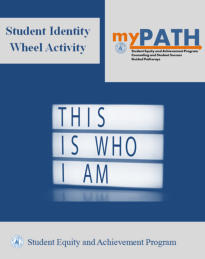Identity Wheel Activity - Who Am I?
Introduction
Briefly stated, the ultimate aim of student-centered learning is “to support the learner to actively construct
meaning.” David Jonassen and Susan Land in their work entitled Theoretical Foundations of Learning
Environments identify the following as some of the key entry points of student-centered learning:
•
The “centrality of the learner in defining meaning.”
•
“Scaffolded participation in authentic tasks and sociocultural practices.”
•
The “importance of prior and everyday experiences in meaning construction.
•
Access to “multiple perspectives, resources, and representations.”
Before faculty can begin infusing these entry points into their curriculum they must first know who their
students are since they will be the focus of this asset-based pedagogy. One way to accomplish this objective is
by having student share their identity with faculty. Identity (personal and social) is the “set of traits and
characteristics, social relations, roles and group membership that define who one is.” These identities can be
self –claimed or ascribed by others. An individual’s identity impacts how one perceives and mediates the world
and their place in that world. For example, a faculty members’ identity will undoubtedly impact their curricular
and pedagogical approaches to the classroom. It will also define their interactions and relationships with
students. In the same manner, a student’s identity will impact how they perceive and approach learning in the
classroom.
Along with identity, individuals also possess funds of knowledge, “skills, abilities, ideas, practices and ways of
knowing accumulated and internalized from everyday life.” Funds of knowledge are acquired through an
individual’s historical interaction with their family life, culture and community. Learning what funds of
knowledge students bring to the classroom, along with identity, can facilitate structuring a student-centered
learning and equitable environment.
The following is a hybrid student assignment entitled Who Am I. The assignment objectives seek to
accomplish the following:
•
To have students reflect on what makes up their identity.
•
To have students explore if their identity grants them societal/cultural advantages or does it produce
societal/cultural disadvantages at El Camino College.
•
To have students explore how they are perceived because of their identity and how their identity shapes
how they perceive the world around them.
•
To have students revisit the factors that shape social power and explore if identity plays a role in its
construction.
The assignment also helps faculty gain insights about how students define their identity. Using this information
as a foundation, faculty can now create student-centered and equity-minded designs for the classroom that taps
into their student’s identity and funds of knowledge.
Part one of the assignment is give student access the Who Am I? packet. They will be asked to take it home,
read it, and reflect on its content.
Who Am I? Student Packet
Once they have completed reading the packet students will next be asked to provide answers to the questions in
the packet in an online form. The form is anonymous and students should be made aware of this.
Example of Who Am I? Online Form
Download Copy of Who Am I? Online Form
Contact Jason R. Suárez (jsuarez@elcamino.edu) should you have any questions about the content or how to
implement this activity in your course.





Jason Suarez
jsuarez@elcamino.edu
SEA Faculty Coordinator
Wendy Lozano
wlozano@elcamino.edu
SEA Student Services Specialist
Student Equity and Achivement Program



““In order to draw on students’ funds of knowledge teachers can create activities, projects, and
lessons that allow for students to further the different types of knowledge that they have gathered
from the home and their lived experiences and connect it to what they learn in school.” - Stacy D.
Saathoff, Funds of Knowledge and Community





